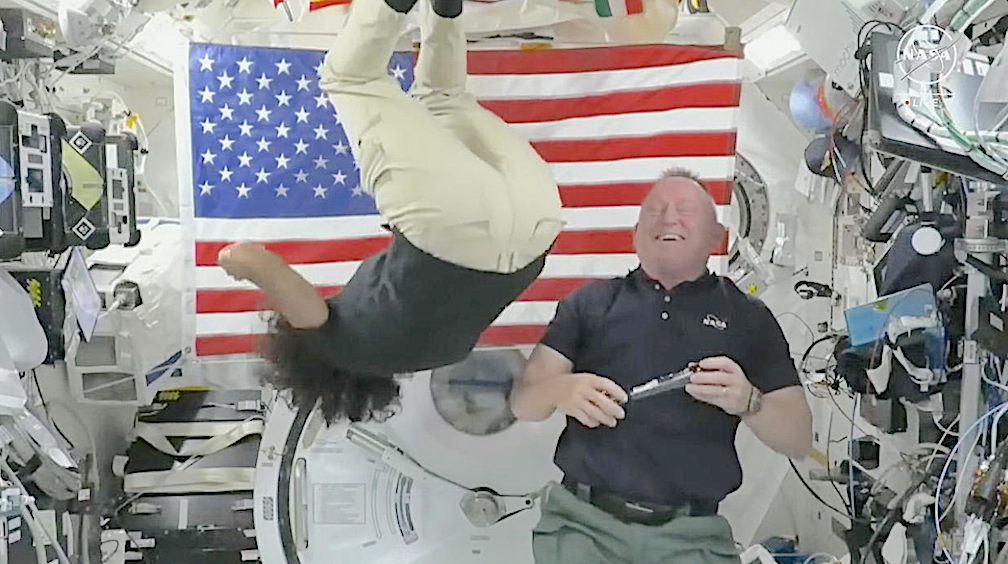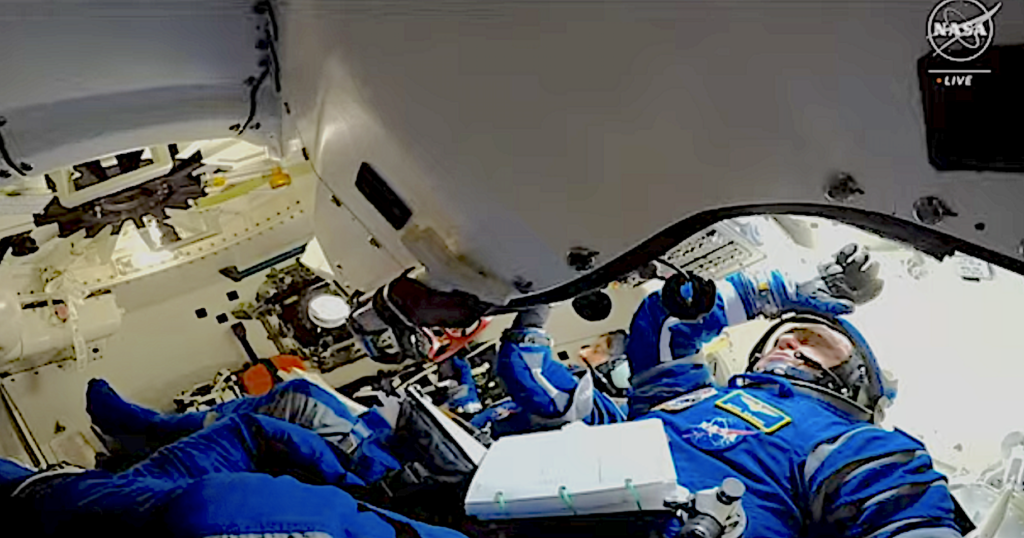
The following are Boeing’s accounts presented in business journal format reporting a situation, except these updates are regarding an ‘extended stay’ of NASA’s astronauts stranded on the International Space Station. The first sentences read:
— Starliner crew wraps up third week in space Wednesday started as any other morning on-orbit for Starliner’s maiden crew, astronauts Butch Wilmore and Suni Williams. Their exercise routine was followed by organizing cargo inside
— Starliner crew enters fourth week on orbit while teams prepare for ground testing NASA astronauts Butch Wilmore and Suni Williams climbed into Starliner at the International Space Station and worked with Boeing flight controllers and engineers
— On the Starliner crew’s 35th day in space, Crew Flight Test Commander Butch Wilmore brought the focus back to day one. “Launch was spectacular! I mean, truly amazing,” Wilmore said.
During the first press conference between Wilmore, pilot Suni Williams, and the media, he praised Starliner for its precision. “The spacecraft performed unbelievably well,” Wilmore said. “We have these things called the Cooper-Harper Pilot Rating Scale — one to ten. One being the best, ten being the worst.”

The Cooper-Harper Pilot Rating Scale, or CHPRS, is an evaluation tool for test pilots and engineers. On the scale, a one defines aircraft or spacecraft characteristics as “excellent” and “highly desirable” and means pilot compensation is not a factor for the desired performance.
“I’ve never given a one in all my flight test years for handling qualities, but I was tempted,” Wilmore said. “That’s how precise this spacecraft controlled in all aspects of the various tests we did.”
Although the spacecraft is usually autonomous, the crew used the hand controller to point and aim the spacecraft during about two hours of free-flight demonstrations on the day of launch. Then, on the day of docking, the crew took over manual control for about an hour on the V-bar, which is the axis when Starliner rendezvous with the International Space Station. Wilmore said even though five thrusters had been taken offline at the time, Starliner’s handling was still impressive.

“Coming into docking, those final ten meters, we have a tolerance when we actually connect with the space station (autonomously) of five degrees in attitude and about four inches in position,” Wilmore said. “Starliner came right down the middle, even with the degraded thrusters, which was truly impressive.”
The crew told reporters they’ve been doing science and maintenance on the ISS since they arrived. They fixed the station’s urine processor with a new pump brought up on Starliner. Williams said she performed gene sequencing and Wilmore conducted experiments with a 3-D printed moon microscope.
“We’ve been thoroughly busy up here,” said Williams. She said they have been integrated right into the crew – in which they’re now dubbing “Expedition 71-plus.”
Following the crew’s comments about Starliner’s launch and docking, members of the media asked about their return home. “I have a real good feeling in my heart that this spacecraft will bring us home no problem,” said Williams.
She said it is great to be back on the orbiting laboratory and feels like home to them. “I’m not complaining, Butch isn’t complaining, that we’re here for a couple of extra weeks.”
All work stopped for the Starliner ground teams Wednesday at 11:00 a.m. ET so they could listen to the crew speak from space. “We are very close and friends with those who are making these decisions and we trust them,” said Wilmore. “We trust their integrity.”
Boeing assures “we have the luxury of time” as Starliner stuck with NASA’s astronauts at ISS for one month



An update regarding the happenings with Boeing problem solving the repair and return of NASA’s astronauts. What began as an intended eight day venture has proven to be one month as of July 6.
“We’re not stuck on ISS. The crew is not in any danger, and there’s no increased risk when we decide to bring Suni and Butch back to Earth,” said Mark Nappi, manager of Boeing’s Commercial Crew Program.
Ken Bowersox, an associate administrator at NASA, said the delay will allow for the collection of more data and that there is no hurry to bring the astronauts back. “We have the luxury of time,” he said.
The teams on-console in NASA’s Mission Control Center in Houston and Boeing’s Mission Control Center at Kennedy Space Center checked out various systems of the spacecraft with the crew, including repressurizing the propellant manifolds. They also conducted mission data loads, or MDLs, which are files for the spacecraft’s computer to understand current inertial and relative navigation states, Earth rotation, and thermal conditioning on thrusters used during Starliner’s return, and more.
“We updated some products on board to support the continued docked duration through the month of July and through the higher positive beta periods we are approaching,” said Chloe Mehring, the Starliner flight director who coordinated the power-up actions with Wilmore and Williams. “Starliner is healthy and no anomalies were written against the spacecraft.”

At the last few minutes the astronauts’ nerves are beginning to show. Photo captured on Saturday, June 1, by Satnews from ULA video stream.
Beginning this week, teams will run the thruster through similar conditions that Starliner experienced after launch on the way to the space station. The tests will include replicating the phase of the Crew Flight Test from launch to docking. Then tests will be performed to replicate what thrusters will experience from undocking to landing.
“We really want to understand the thruster and how we use it in flight,” said Dan Niedermaier, the lead Boeing engineer for the thruster testing. “We will learn a lot from these these thruster firings that will be valuable for the remainder of the Crew Flight Test and future missions.”
Additional Operational Checkout Capabilities (OCC) that were added during testing included tablet and procedure updates. Camera and tablet batteries were also charged while the spacecraft was fully powered up. Before launch, NASA had said the batteries aboard Starliner were rated for 45 days but during the press conference they indicated they were performing well and would be rated to last another 45 days. On regular missions to service the station, Starliner would stay docked for six months.
Both Boeing and SpaceX received multibillion-dollar contracts in 2014 to develop their projects. Since 2020 SpaceX’s Crew Dragon capsule has carried more than half a dozen crews to the ISS. Boeing has conducted two remote flights, one that failed to reach orbit and a second in May 2022 that docked with the orbiting lab.
The current mission with astronauts aboard was scheduled to launch last year but was delayed due to the need to replace flammable tape used extensively in Starliner and a second issue with the parachute system that will slow its descent for a ground landing in the Southwest.
Last month SpaceX, now valued at a record $210 billion, was awarded a NASA contract worth as much as $843 million to build a spacecraft to guide the International Space Station out of orbit so it can burn up in the atmosphere when it is retired in 2030.
Should Boeing’s Starliner get certified, the dismantling of the space station would offer several scheduled service flights. Due to this small number of possible transports there is speculation that Boeing may end the program. Boeing states that Starliner could still be used to service the Orbital Reef orbiting station under development by Jeff Bezos’ Blue Origin company.
